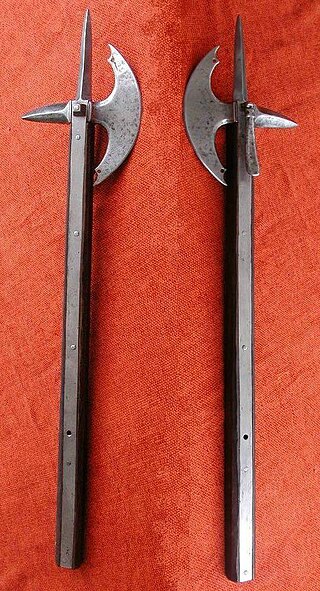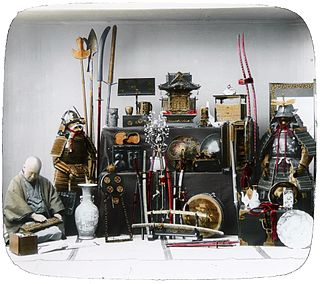
Dual wielding is the technique of using two weapons, one in each hand, for training or combat. It is not a common combat practice. Although historical records of dual wielding in war are limited, there are numerous weapon-based martial arts that involve the use of a pair of weapons. The use of a companion weapon is sometimes employed in European martial arts and fencing, such as a parrying dagger. Miyamoto Musashi, a Japanese swordsman and ronin, was said to have conceived of the idea of a particular style of swordsmanship involving the use of two swords.

Infantry is a specialization of military personnel who engage in warfare combat. Infantry generally consists of light infantry, irregular infantry, heavy infantry, mountain infantry, motorized infantry, mechanized infantry, airborne infantry, air assault infantry, and naval infantry. Other types of infantry, such as line infantry and mounted infantry, were once commonplace but fell out of favor in the 1800s with the invention of more accurate and powerful weapons.

Filipino martial arts (FMA) refer to ancient and newer modified fighting methods devised in the Philippines. It incorporates elements from both Western and Eastern Martial Arts; the most popular forms of which are known as Arnis, Eskrima, and Kali. The intrinsic need for self-preservation was the genesis of these systems. Throughout the ages, invaders and evolving local conflict imposed new dynamics for combat in the islands now making up the Philippines. The Filipino people developed battle skills as a direct result of an appreciation of their ever-changing circumstances. They learned, often, out of necessity on how to prioritize, allocate and use common resources in combative situations. Filipinos have been heavily influenced by a phenomenon of cultural and linguistic mixture. Some of the specific mechanisms responsible for cultural and martial change extended from phenomena such as war, political and social systems, technology, and trade and practicality.

A buckler is a small shield, up to 45 cm in diameter, gripped in the fist with a central handle behind the boss. It became more common as a companion weapon in hand-to-hand combat during the Medieval and Renaissance periods. Its size made it poor protection against missile weapons but useful in deflecting the blow of an opponent's weapons, binding his arms, hindering his movements, or punching him.

Swordsmanship or sword fighting refers to the skills and techniques used in combat and training with any type of sword. The term is modern, and as such was mainly used to refer to smallsword fencing, but by extension it can also be applied to any martial art involving the use of a sword. The formation of the English word "swordsman" is parallel to the Latin word gladiator, a term for the professional fighters who fought against each other and a variety of other foes for the entertainment of spectators in the Roman Empire. The word gladiator itself comes from the Latin word gladius, which is a type of sword.

The chakram is a throwing weapon from the Indian subcontinent. It is circular with a sharpened outer edge and a diameter of 12–30 cm (4.7–11.8 in). It is also known as chalikar meaning "circle", and was sometimes referred to in English writings as a "war-quoit". The chakram is primarily a throwing weapon, but can also be used hand-to-hand. A smaller variant called chakri is worn on the wrist. A related weapon is the chakri dong, a bamboo staff with a chakri attached at one end.
Ancient warfare is war that was conducted from the beginning of recorded history to the end of the ancient period. The difference between prehistoric and ancient warfare is more organization oriented than technology oriented. The development of first city-states, and then empires, allowed warfare to change dramatically. Beginning in Mesopotamia, states produced sufficient agricultural surplus. This allowed full-time ruling elites and military commanders to emerge. While the bulk of military forces were still farmers, the society could portion off each year. Thus, organized armies developed for the first time. These new armies were able to help states grow in size and become increasingly centralized.

A battle axe is an axe specifically designed for combat. Battle axes were specialized versions of utility axes. Many were suitable for use in one hand, while others were larger and were deployed two-handed.

The Hyborian Age is a fictional period of Earth's history within the artificial mythology created by Robert E. Howard, serving as the setting for the sword and sorcery tales of Conan the Barbarian.
The Book of Swords Series is a series of science fiction/fantasy novels written by Fred Saberhagen from 1983 to 1995. The story revolves around the Twelve Swords of Power, which were forged by the gods and given to humanity, and how various characters acquire and use them. The series spans several decades and features dozens of characters.

In mythology, legend or fiction, a magic sword is a sword with magical powers or other supernatural qualities. Renowned swords appear in the folklore of every nation that used swords.
Indian martial arts refers to the fighting systems of the Indian subcontinent. A variety of terms are used for the English phrases "Indian martial arts", deriving from ancient sources. While they may seem to imply specific disciplines, by Classical times they were used generically for all fighting systems.
The weapon dance employs weapons—or stylized versions of weapons—traditionally used in combat in order to simulate, recall, or reenact combat or the moves of combat in the form of dance, usually for some ceremonial purpose. Such dancing is quite common to folk ritual on many parts of the world. Weapon dancing is certainly ancient; among the earliest historical references we have are those that refer to the pyrrhichios, a weapon dance in ancient Sparta, in which the dance was used as a kind of ritual training for battle.

A javelin is a light spear designed primarily to be thrown, historically as a ranged weapon. Today, the javelin is predominantly used for sporting purposes such as the Javelin throw. The javelin is nearly always thrown by hand, unlike the sling, bow, and crossbow, which launch projectiles with the aid of a hand-held mechanism. However, devices do exist to assist the javelin thrower in achieving greater distances, such as spear-throwers or the amentum.

Close combat is a combat situation between two or more opponents at short range. Since the rise of ranged weapons and firearms, the term has been used to specifically refer to melee combat.
Historically, Chinese swords are classified into two types, the jian and the dao. A Jian is a straight, double-edged sword mainly used for stabbing, and has been commonly translated into the English language as a longsword; while a dao is a single-edged sword mainly used for cutting, and has been translated as a saber or a "knife".

Major innovations in the history of weapons have included the adoption of different materials – from stone and wood to different metals, and modern synthetic materials such as plastics – and the developments of different weapon styles either to fit the terrain or to support or counteract different battlefield tactics and defensive equipment.












